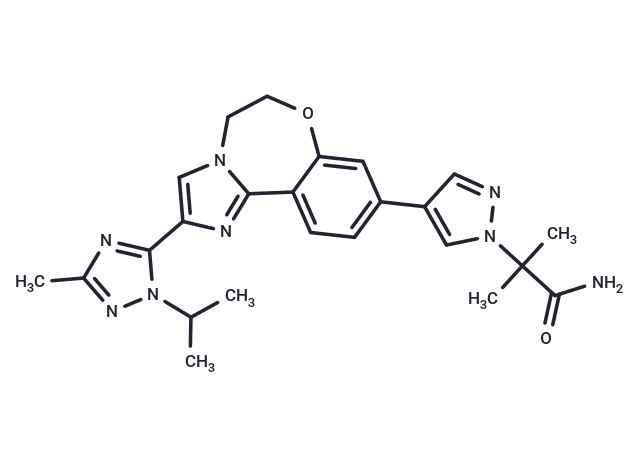Shopping Cart
- Remove All
 Your shopping cart is currently empty
Your shopping cart is currently empty

Taselisib (GDC-0032) is an orally bioavailable inhibitor of the class I phosphatidylinositol 3-kinase (PI3K) alpha isoform (PIK3CA), with potential antineoplastic activity.

| Pack Size | Price | Availability | Quantity |
|---|---|---|---|
| 2 mg | $38 | In Stock | |
| 5 mg | $61 | In Stock | |
| 10 mg | $93 | In Stock | |
| 25 mg | $159 | In Stock | |
| 50 mg | $207 | In Stock | |
| 100 mg | $369 | In Stock | |
| 200 mg | $549 | In Stock | |
| 500 mg | $885 | In Stock | |
| 1 mL x 10 mM (in DMSO) | $61 | In Stock |
| Description | Taselisib (GDC-0032) is an orally bioavailable inhibitor of the class I phosphatidylinositol 3-kinase (PI3K) alpha isoform (PIK3CA), with potential antineoplastic activity. |
| Targets&IC50 | PI3Kγ:0.97 nM(Ki), PI3Kα:0.29 nM(Ki), PI3Kβ:9.1 nM(Ki), PI3Kδ:0.12 nM(Ki), C2β:292 nM |
| In vitro | Combination of GDC-0032 with fulvestrant, which enhanced fulvestrant activity, resulted in tumor regression and delayed tumor growth (91% tumor growth inhibition (TGI)). In addition, the combination of GDC-0032 with tamoxifen enhanced the potency of tamoxifen in vivo, and the tumor growth inhibition rate of GDC-0032 was 102%. The pharmacokinetics of GDC-0032 were approximately dose proportional and time independent, with a mean t1/2 of 40 hours. |
| In vivo | Preclinical data indicate that GDC-0032 has increased activity in PI3Kα isoform (PIK3CA) mutant and HER2-expanded cancer cell lines.GDC-0032 inhibits MCF7-neo/HER2 cell proliferation with an IC50 of 2.5 nM.GDC-0032 is an orally bioavailable, potent, and selective inhibitor of class I PI3Kα, δ, and γ isoforms. GDC-0032 is an orally bioavailable, potent and selective inhibitor of class I PI3Kα, δ and γ isoforms, with a 30-fold lower inhibition of PI3Kβ isoforms compared to PI3Kα isoforms. |
| Kinase Assay | Characterization of Biochemical and Cellular Activity in Vitro: Enzymatic activity of the class I PI3K isoforms is measured using a fluorescence polarization assay that monitors formation of the product 3,4,5-inositoltriphosphate molecule as it competes with fluorescently labeled PIP3 for binding to the GRP-1 pleckstrin homology domain protein. An increase in phosphatidyl inositide-3-phosphate product results in a decrease in fluorescence polarization signal as the labeled fluorophore is displaced from the GRP-1 protein binding site. Class I PI3K isoforms are expressed and purified as heterodimeric recombinant proteins. Tetramethylrhodamine-labeled PIP3 (TAMRA-PIP3), di-C8-PIP2, and PIP3 detection reagents are purchased from Echelon Biosciences. PI3Kα is assayed under initial rate conditions in the presence of 10 mM Tris (pH 7.5), 25 μM ATP, 9.75 μM PIP2, 5% glycerol, 4 mM MgCl2, 50 mM NaCl, 0.05% (v/v) Chaps, 1 mM dithiothreitol, and 2% (v/v) DMSO at 60 ng/mL. After assay for 30 min at 25 °C, reactions are terminated with a final concentration of 9 mM EDTA, 4.5 nM TAMRA-PIP3, and 4.2 μg/mL GRP-1 detector protein before reading fluorescence polarization on an Envision plate reader. IC50 values are calculated from the fit of the dose-response curves to a 4-parameter equation. Each reported value is an average of three experiments, and all have a standard deviation less than one geometric mean. |
| Cell Research | GDC-0032 is dissolved in DMSO. Cells are seeded in replicates of 6 in 96-well plates with 500 to 5,000 cells/well overnight and then treated with GDC-0032. After 4 days, the media are removed and the cells are fixed with 4% glutaraldehyde for 30 minutes. Fixed cells are stained with 0.1% crystal violet for 2 minutes, then washed, and dissolved in 10% acetic acid. |
| Alias | RG-7604, GDC-0032 |
| Molecular Weight | 460.53 |
| Formula | C24H28N8O2 |
| Cas No. | 1282512-48-4 |
| Smiles | CC(C)n1nc(C)nc1-c1cn2CCOc3cc(ccc3-c2n1)-c1cnn(c1)C(C)(C)C(N)=O |
| Relative Density. | 1.40 g/cm3 (Predicted) |
| Storage | Powder: -20°C for 3 years | In solvent: -80°C for 1 year | Shipping with blue ice. | ||||||||||||||||||||||||||||||
| Solubility Information | DMSO: 40 mg/mL (86.86 mM), Heating is recommended. Ethanol: < 1 mg/mL (insoluble or slightly soluble) | ||||||||||||||||||||||||||||||
Solution Preparation Table | |||||||||||||||||||||||||||||||
DMSO
| |||||||||||||||||||||||||||||||

Copyright © 2015-2025 TargetMol Chemicals Inc. All Rights Reserved.